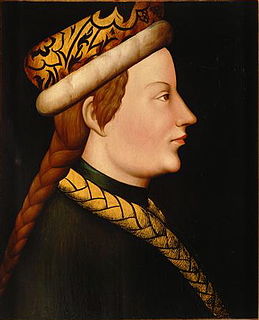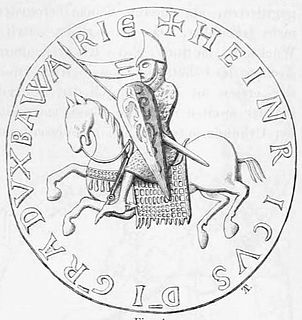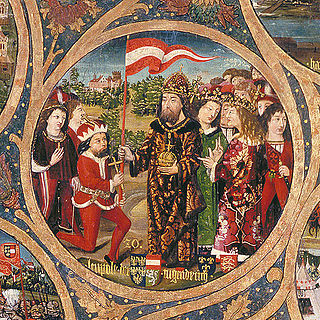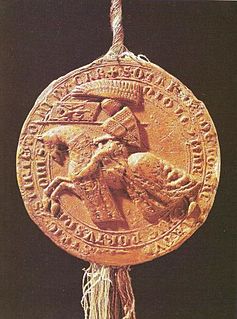 W
WAlbert I of Habsburg, the eldest son of King Rudolf I of Germany and his first wife Gertrude of Hohenberg, was a Duke of Austria and Styria from 1282 and King of Germany from 1298 until his assassination.
 W
WAlbert II, known as the Wise or the Lame, a member of the House of Habsburg, was duke of Austria and Styria from 1330, as well as duke of Carinthia and margrave of Carniola from 1335 until his death.
 W
WAlbert III of Austria, known as Albert with the Braid (Pigtail), a member of the House of Habsburg, was Duke of Austria from 1365 until his death.
 W
WAlbert IV of Austria was a Duke of Austria.
 W
WFrederick I, known as Frederick the Catholic, was the Duke of Austria from 1195 to 1198. He was a member of the House of Babenberg.
 W
WFrederick II, known as Frederick the Quarrelsome, was Duke of Austria and Styria from 1230 until his death. He was the fifth and last Austrian duke from the House of Babenberg, since the former margraviate was elevated to a duchy by the 1156 Privilegium Minus. He was killed in the Battle of the Leitha River, leaving no male heirs.
 W
WFrederick the Handsome or the Fair, from the House of Habsburg, was Duke of Austria and Styria from 1308 as Frederick I as well as King of Germany from 1314 as Frederick III until his death.
 W
WHenry II, called Jasomirgott, a member of the House of Babenberg, was Count Palatine of the Rhine from 1140 to 1141, Duke of Bavaria and Margrave of Austria from 1141 to 1156, and the first Duke of Austria from 1156 until his death.
 W
WHerman VI was Margrave of Baden and titular margrave of Verona from 1243 until his death.
 W
WLeopold I from the House of Habsburg was Duke of Austria and Styria – as co-ruler with his elder brother Frederick the Fair – from 1308 until his death. Born at Vienna, he was the third son of King Albert I of Germany and Elisabeth of Gorizia-Tyrol, a scion of the Meinhardiner dynasty.
 W
WLeopold III, known as the Just, a member of the House of Habsburg, was Duke of Austria from 1365. As head and progenitor of the Leopoldian line, he ruled over the Inner Austrian duchies of Carinthia, Styria and Carniola as well as the County of Tyrol and Further Austria from 1379 until his death.
 W
WLeopold V, known as the Virtuous, a member of the House of Babenberg, was Duke of Austria from 1177 and Duke of Styria from 1192 until his death.
 W
WLeopold VI, known as Leopold the Glorious, was the Duke of Styria from 1194 and the Duke of Austria from 1198 to his death in 1230. He was a member of the House of Babenberg. Like his predecessors, he attempted to develop the land by founding monasteries. His most important foundation is Lilienfeld in the Lower Austrian valley of the Traisen river, where he was buried after his death. Besides that, he supported the then highly modern Mendicant Orders of the Franciscans and Dominicans.
 W
WLeopold II, Duke of Austria, a member of the House of Habsburg, was the younger son of Duke Otto the Merry.
 W
WMaximilian, Duke von Hohenberg, was the elder son of Archduke Franz Ferdinand of Austria-Hungary and his wife Countess Sophie Chotek von Chotkowa und Wognin, Duchess von Hohenberg. Because his parents' marriage was morganatic, he was excluded from succession to the Austro-Hungarian throne, to which his father was heir presumptive, and to inheritance of any of his father's dynastic titles, income, and properties, although not from the archduke's personal estate nor from his mother's property.
 W
WOtto, the Merry, a member of the House of Habsburg, was Duke of Austria and Styria from 1330, as well as Duke of Carinthia from 1335 until his death. He ruled jointly with his elder brother Duke Albert II.
 W
WOttokar II, the Iron and Golden King, was a member of the Přemyslid dynasty who reigned as King of Bohemia from 1253 until his death in 1278. He also held the titles of Margrave of Moravia from 1247, Duke of Austria from 1251, and Duke of Styria from 1260, as well as Duke of Carinthia and landgrave of Carniola from 1269.
 W
WRudolf IV, also called Rudolf the Founder, was a scion of the House of Habsburg who ruled as duke of Austria, Styria and Carinthia from 1358, as well as count of Tyrol from 1363 and as the first duke of Carniola from 1364 until his death. After the Habsburgs got nothing from the decree of the Golden Bull in 1356, he gave order to draw up the "Privilegium Maius", a fake document to empower the Austrian rulers.
 W
WRudolf I, also known as Rudolf of Habsburg, was Count of Habsburg from about 1240 and King of the Romans from 1273 until his death.
 W
WRudolf I, a member of the House of Habsburg, was King of Bohemia and titular King of Poland from 1306 until his death. He was also Duke of Austria and Styria from 1298.